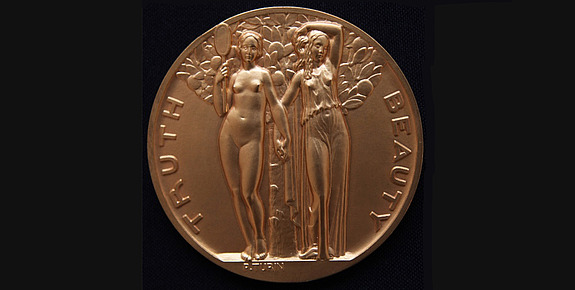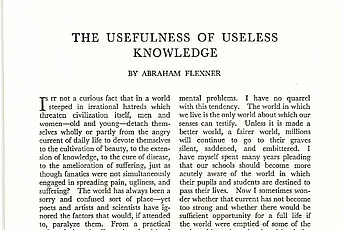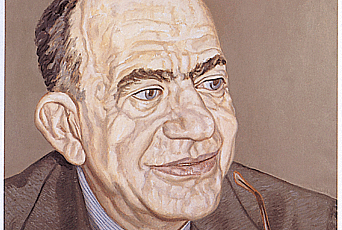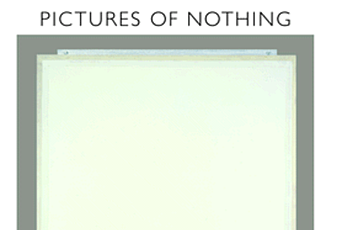Truth and Beauty at the Institute for Advanced Study

The need for an official Institute seal was one of the first things that Abraham Flexner, founding Director of the Institute, turned his attention to even before preliminary financial and practical arrangements were in place. Irving Lavin (1927–2019), Professor Emeritus in the School of Historical Studies, and his wife and colleague, Marilyn Aronberg Lavin, trace the seal’s origins and influences—among them the final couplet of John Keats’s “Ode on a Grecian Urn”—and articulate why and how its elements and design embody the rare and very modern mission of the Institute. “The radical nature of Flexner’s twinning of science and humanism with truth and beauty arose in part from the radical nature of his concept for a ‘modern’ university,” writes Irving Lavin, “by which he meant a university devoted exclusively to the pursuit of higher learning for its own sake and without regard to practical value.”
“Beauty is truth, truth beauty,”—that is all
Ye know on earth, and all ye need to know.
—final couplet of John Keats’s “Ode on a Grecian Urn”
Almost as soon as I arrived at the Institute in 1974 and saw the official seal, I was intrigued by the poetic beauty and formal simplicity of this eminently pictorial image, quite unlike the abstract epigraphic tradition of academic heraldry. In a circular format, the quiet, elegant, and classical Art Deco composition depicts two graceful young women, one nude and one clothed, standing on opposite sides of a leafy tree that bears abundant fruit. Their poses are complementary, one looking out toward the spectator, the other looking down, avoiding eye contact. The figures are named in large letters sans serif, TRUTH to the left, BEAUTY on the right. Truth holds a mirror that overlaps the circular frame to reflect reality. On the exergue, at the bottom of the circle, in smaller letters, is the artist’s signature, P. TURIN. What struck me most was the extraordinary intellectual acumen that underlay the evident allusion, in both the conceit and the design of the emblem—conveying the essence of the mission of the Institute for Advanced Study—to the famous final couplet of John Keats’s “Ode on a Grecian Urn.” With a mind to study the genesis and significance of this remarkable image, I subsequently spoke with Harry Woolf, the Director at the time, who gave me access to a file of letters and other documents pertaining to the seal, which I carefully stashed away. They languished for more than thirty years thereafter as other projects intervened, until it became, now or never. . . .
Recommended Reading: A longer study by the Lavins on the history and significance of the Institute seal may be found here.
In its final form, the study is divided into separately written parts: Marilyn Aronberg Lavin begins with the history of the project to invent and bring into physical form what remains the official seal of the IAS. My analysis then follows, setting the imagery of the seal and its meaning into the context of the ideas that brought the Institute into being.––Irving Lavin
At the end of 1929, two years after he had delivered his three controversial Rhodes Trust Memorial Lectures at Oxford University criticizing the sorry state of education in English, German, and American universities, Abraham Flexner was approached by two agents of the Bamberger family who wished to find “uses to which a considerable sum of money might be placed.” Flexner said immediately that his competency was limited to the educational field and that in this field it seemed to me that the time was ripe for the creation in America of an institute in the field of general scholarship and science, resembling the Rockefeller Institute in the field of medicine—developed by my brother Simon—not a graduate school, training men in the known and to some extent in methods of research, but an institute where everyone—faculty and members—took for granted what was known and published, and in their individual ways endeavored to advance the frontiers of knowledge.
After two months of reflection on a plan drafted by Flexner, Louis Bamberger and his sister, Carrie (Mrs. Felix Fuld), announced that they were resolved to endow such an institute with the condition that Flexner, who considered himself retired, would undertake the organization. Flexner responded that for such a decision he had to consult with his wife, Anne Crawford Flexner. He describes her reaction to the Bamberger offer thus:
Quick as a shot she rejoined, “You will have to do it. You have spent your life criticizing other people. You can’t refuse to give them a chance to criticize you.” Thus he accepted the position.
One of the first things he turned his attention to, even before the preliminary financial and practical arrangements were in place, was the need to represent the Institute graphically with an official seal. He writes:
The new Institute for Advanced Study has got to have a seal, and I have been asked to procure a sketch—something very simple and characteristic. The notes that I would like struck are Truth and Beauty—not Truth alone, for I agree with you that both are elements in a national culture. I should also like English, not Latin or Greek used. Could you make a little sketch which would convey this idea?
Flexner was calling for help with the seal’s design from his good friend William Welles Bosworth, a prominent American architect with a long list of important buildings to his credit. . . . Bosworth, who was also a more-than-competent artist, responded with enthusiasm:
I was delighted to have you call on me about the seal, and I would even go so far as to suggest that . . . after we have agreed on a design—the thing should be modeled and cut by a great artist over here named Turin. . . .
The extraordinary motto Truth and Beauty borrowed from Keats’s “Ode on a Grecian Urn,” apart from its appropriateness for the idea of the Institute (which Flexner called his “dream”), had great personal significance for Flexner and his wife Anne. In his introduction to the 1960 edition of Flexner’s autobiography, his close friend Allan Nevins (1890–1971), American historian and journalist, reports that Abraham loved to recite this poem at private social gatherings, which he did, of course, from memory. Mrs. Flexner, Anne Crawford Flexner, who was a quite successful Broadway playwright (Mrs. Wiggs of the Cabbage Patch was her greatest success), in this period did much research on Keats and then wrote and produced the play Aged 26: A Play about John Keats.––Marilyn Aronberg Lavin
We have no idea if Flexner had any idea what the seal he requested was to look like. But no less remarkable than Flexner’s thought was what happened when Bosworth received the request and Turin responded to it. . . .
Bosworth, with Turin’s agreement, introduced a third element according to what he called “the law of three.”
(Turin) agreed with me that to make a good-looking Seal, we ought to have three things instead of two. In other words, the Tree of Knowledge growing out of Truth and Beauty, as the third, uniting the two.
The next time I see you, I will give you a long lecture on the law of three—in all things visual. I am hoping that you will agree that the fruit of pursuing “Truth and Beauty”, in your Institution, is “Knowledge”; and that the force of the “Truth and Beauty” idea, is rather strengthened than weakened, by letting it figure as a fruit-bearing tree, beside which they stand.
It is important to realize that the Law (or Rule) of Three is not the same as Symmetry, for it involves not just the juxtaposition of the parts but also the relationships between them: 
Bosworth’s tertium quid between Truth and Beauty was none other than the Tree of Knowledge—Knowledge as such, as it were—precisely the concept subtended by the oracular urn in the last line of Keats’s Ode to the equation of the two in the preceding line. In my opinion, Bosworth, Turin, and Flexner understood the poem in this way, and thus captured its meaning more profoundly and concisely than any of the commentators I have read. Truth and Beauty are equal, inseparable, and ultimately indistinguishable paths toward one end, Knowledge, which is indeed all we can or need to know on earth, and the pursuit of which is exactly the kind of research Flexner envisioned for his new Institute.
In a way, I think the Tree of Knowledge bearing apple-like fruit was the boldest invention of all. Placed between the two figures according to the Rule of Three, it inevitably evokes, and I suspect was deliberately intended to do so, the traditional portrayal of the Temptation of Adam and Eve, to whom the fruit revealed the knowledge of good and evil, whence they were expelled from Paradise into this world, where they were condemned to labor for their sustenance. The labors required by the Institute’s Tree were the pursuit of Truth and Beauty, and the Knowledge that on earth they are identical and sufficient.
While the association of Truth and Beauty with the program of the Institute may seem obvious and natural to us today, it certainly was not when Flexner made the association. Flexner’s knowledge and appreciation of the Ode were profound; his wife Anne did serious and extensive research for the play—Aged 26—she wrote and produced about the poet’s death. But the linkage between the Ode and the Institute required a fundamental leap of the imagination, which sprang, I think, from Flexner’s much earlier, indeed lifelong, and much broader concern with problems of education and intellectual endeavor, most especially in modern America. . . .
The radical nature of Flexner’s twinning of science and humanism with truth and beauty arose in part from the radical nature of his concept for a “modern” university by which he meant a university devoted exclusively to the pursuit of higher learning for its own sake and without regard to practical value.... Science and the humanities—these polar extremes that touch—were at the forefront of Flexner’s mind when he formulated the Institute’s logo, commemorating the paradoxical conjunction of opposites in the Institute’s mission with the paradoxical closing lines of the “Ode on a Grecian Urn,” where the extremes of Truth and Beauty touch in their common search for knowledge. ––Irving Lavin


